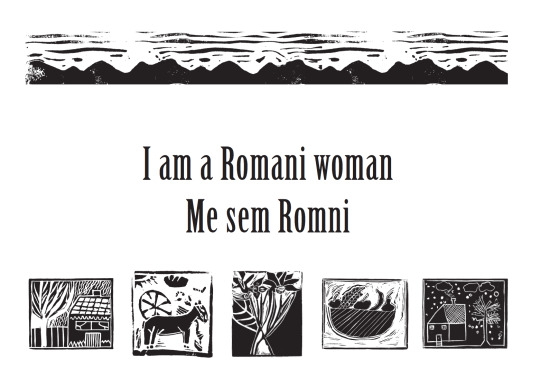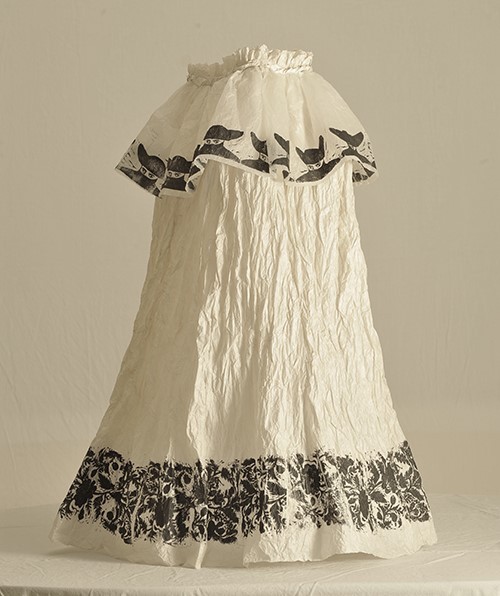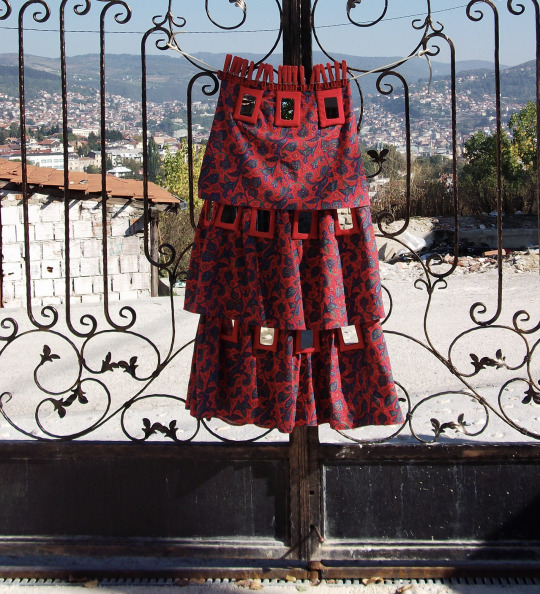#Hedina Sijerčić
Text
I go home.
The door is open.
No one is home.
Mother! Father!
No one responds.
Sisters! Brother!
No one answers.
The house door is open.
Perhaps they’ve gone to my uncle.
I go and check.
They’re not there.
My family is gone.
There’s no one.
I re-enter my house
I sit down.
I prepare coffee and drink it alone.
I see everything as it was:
Soup on the stove,
Roasted meat in a pan,
Salad and baked bread on the low Turkish table
I eat the soup prepared by my mother
And go out the door
The sun is scorching.
Maybe they went to the Turbe.
I pass through the upper part of the Quarter
Leading to the Turbe.
There are no Roma in the Quarter
I pass by the homes
Of Alija, Lafita, and Husica,
Nura and Selma.
I look inside, wanting to see Meha and Safija Sejdic
Their cab sits in front of the entry.
Smoke rises from the stovepipe
They’re cooking for the grandchildren again
But there are no Roma.
I get up and proceed.
On my left are garages
and on their roofs, old auto parts
and scrap iron.
Water gushes from the taps
Someone’s pipes are broken again.
I walk slowly because I really want
to observe the Quarter.
Once more my gaze follows the houses,
now to the right
I pass the house where Bajro and Grozda Tahirovic lived.
Now Refik and his family live there – Kosovar Roma.
New Roma have come to the Quarter.
I go on and come to the tiny house
of old Muste and Zejfa
A brother and sister who never married
They know how to fight and swear like no one else on earth.
They are the best.
But there are no Roma.
Between these two houses lies the way to the small home
Of Bajro Pujpica and Ljubica Besic, Ema and
Ramo Mrvica and Celo Tahirovic.
I continue on.
Here lives Bajro Tahirovic, and beside him
Mejra and Tale, Hajra and Bugar Sejdic,
Raba and Ramiz Besic,
and the home of the family Hasanovic.
But there are no Roma.
The Quarter is empty.
I go on, crying.
I see the Turbe.
Father’s car isn’t here.
I leave behind the house that belongs to
Iso and Hajra, and the son Kemo.
They aren’t there either.
I look down and among the shacks
where Kaja and Paso lived, Cina and Musa,
Tuna and Trajan with their children.
So much garbage around the shacks!
Ripped, old, dirty skirts and dresses,
Filthy, tattered shoes, spoiled food and paper.
Continuing on, I see a tent.
A ripped, pathetic, poor man’s tent.
Kaja sits before it, as usual.
A fire burns
In front of it, a piece of sheet metal
And on the metal sits a Turkish pot
black coffee inside.
Good little Kaja.
She kisses me.
In the shade of the tent sleep five children
I sit and drink coffee with Kaja.
I want to ask about my family
And where they have gone.
Fear takes away my voice.
Menacing sounds of aircraft above!
I tremble with fright
My blood freezes.
Kaja and the children scatter.
Grenades! Bombs!
I awake startled
in a foreign land.
— Hedina Tahirović-Sijerčić, Dream 2, from "Dream 1, Dream 2"
#romani#roma#bosnia and herzegovina#bosna i hercegovina#bosna#hedina tahirović-sijerčić#poetry#writing#gurbeti
13 notes
·
View notes
Text
Beyond the Roma Caravan (2) / Suzana Milevska’s Testimony: Meet Lynn Hutchinson Lee and Hedina Sijerčić

Canada Without Shadows: I am a Romani Woman - Kanada Bizo Uchalipe: Me Sem Romni is a small 24-page book featuring the testimonies and artwork of five Hungarian Romani women.
The very brilliant Suzana Milevska shares her second installment of Beyond The Roma Caravan with Gender Assignment! She writes at the intersection of feminist and Roma issues, which are so under-represented and yet have so much to bring to a conversation on the inherent nomadicism in geopolitical and climate crisis. “In the wake of the new global political conundrums...this project reveals how the ongoing policy of displacement and deportation of Roma refugees and immigrants is easily “smuggled” under the label of nomadic history and culture of Roma.”
I first met Lynn Hutchinson Lee and Hedina Sijerčić in Skopje, back in May 2010. The context of my first encounter with the artists was the first curatorial meeting with the short-listed artists for the Roma Pavilion 2011 which took place after the first round of the selection of applications (collected through an international call that was issued in February 2010). It’s been more than eight years since then, and in meanwhile we’ve met just a couple of times. However our first meeting was highly inspiring for me: it profoundly informed and affected my theoretical research and curatorial practice. Recently I was reminded to their artistic collaboration and was motivated to include their project in this series of posts because of the pertinent refugee crisis in Europe that also heavily affected the condition of Roma refugees in Canada – their project in my view was in a way anticipatory and still highly resonates with the current political situation of Roma across the world.
During our first meeting Lynn and Hedina presented themselves as two Romani woman artists comprising the artist collective chirikli. At that time they were working on their joint project Canada Without Shadows / Kanada Bizo Uchalipe. The project was not yet completed, but was definitely a proposal that attracted the attention of the international jury and was one of the projects that was selected unanimously during the first round. Canada without Shadows was however not a project that one could easily anticipate and grasp in its entirety and complexity without knowing much about its authors’ cultural and ethnic background.
Whilst Lynn was a descendent of Romanichal Lee travellers from Great Britain and was living and working in Toronto, Canada, Hedina was from Bosnia and Herzegovina, at that time living and working in Germany. Lynn is mainly a visual artist, and Hedina was first better known (at least until then) as a writer, journalist and educator. It was therefore not easy to understand how the two artists met and decided to form the collective and how they managed and would manage to continue the collaboration on joint projects despite the distance - most of the time they were based in different continents. Meeting the artists in person and discussing directly with them their artistic interests and collaborative research methods helped the confirmation of the decision to commission, produce and present their collaborative project at, then, forthcoming Venice Biennale in 2011.
The general meeting in Skopje focused on the ongoing issues of Roma in Europe. Particularly relevant were the debates about the goals and results of the Decade of Roma inclusion (2005-2015) and how the differences and contradictions between different Roma groups across the world – their different languages, cultures, customs, religious beliefs and political aspirations reflect (and should reflect) in arts. We talked about the restrictive laws (both in Europe and Canada) regarding the free movement of Roma, about the difficult conditions of the deported and expulsed Roma as a result of these restrictive laws, and about specificity of Romani internal courts and laws. We talked about the difference between the cultural background and political situation of Romani Travellers and Balkan Roma.
We also talked about Ronald Lee, one of the most renowned and influential Romani Canadian writer, linguist and activist based in Toronto, who was granted an honorary degree in 2014 by Queens University. We talked about his significant contribution towards the development of a critical political discourse regarding Roma (e.g. his participation in the 1971 First Romani World Congress in Orpington and the historical and political decision to use “Roma” as an umbrella term used to encompass different Romani communities), about his participation in the Kris Romani (Romani internal judicial assembly), or about his theoretical contribution to the reader Gypsy Law, the book that inspired Call the Witness project.
What became clear is the need for solidarity of Roma and with Roma vs. the clash within Roma communities regarding the differences in understanding ongoing political, identitarian and gender issues. The tensions between the traditional and conservative values to which most of the Romani communities currently still subscribe and the effect of such politics on women was already then one of the most relevant issues discussed during the internal three-day meeting with the present artists and activists.
Aside from the socio-political context of Roma the project proposals that used different media, genres and artistic strategies while reflecting on such urgent topics was addressed as one of the major departures for the panel discussions. Lynn and Hedina were some of the most active participants in the general discussion who contributed a lot to the gradual shaping of the overall project’s concept with the carefully articulated questions and arguments (although the project was already titled and had a general theoretical concept it still depended on different artistic practices for its completion).

Hungary, in Practice, Lynn Hutchinson Lee, paper, konnyaku paste, rice paste, block print
We were also discussing (particularly during the slots with the individual artists and teams) how to present the content of their own complex research and oral history project in a form of art installation, and how to contextualize their collective’s project in the general frame of the curatorial concept of Call the Witness. After the long discussion about how to combine the content and form, the artistic research with the poetic and the political aspects of the work, Canada Without Shadows was gradually developed into a 4-channel sound-art installation Canada Without Shadows).
Most importantly their project had nothing to do with the usual stereotypes of Roma as nomadic people moving around in caravans and settling only temporarily in various cities’ outskirts. Their professional collaboration and friendship took place on the backdrop of the war in ex-Yugoslavia and was motivated and informed by the displacements, deportations, and exile of Roma (both in Europe and Canada) in the 1990s and 2000s. More precisely both Lynn and Hedina were invested in researching the contradictions stemming from the continuous pursuit of collective identity of Roma groups that are paralleled with the quest of new subjectivity and individual positions of Romani women within their conservative communities and families. Thus the form of urban and natural soundscapes used in Canada Without Shadows consisting of overlaying poetry verses, written and spoken by the artists, and spoken testimonies of five displaced Hungarian Roma women who fled Europe to seek refuge in Canada, turned to be the most appropriate for the artists’ aims. A result of this was 'The Witness Project', a small book of testimonies of five Hungarian Romani women in Canada.
According to the artists the title of the project was linked with the assumption of the Roma refugees that Canada had no “shadows,” and thus it had attracted many Roma families to settle there (as did Lynn’s father long ago). However it soon became clear that the new legal hurdles prevented and still prevent many Roma from receiving the desired refugee status. In the wake of the new global political conundrums I feel that the Roma issues today resonate with the anticipatory results of this artistic research project and felt compelled to revisit it in this context exactly because this project reveals how the ongoing policy of displacement and deportation of Roma refugees and immigrants is easily “smuggled” under the label of nomadic history and culture of Roma. Canada Without Shadows went far beyond the stereotype of caravan.
NOTES
Lynn Hutchinson Lee (artist, Canada) (born 1946) and Hedina Tahirović Sijerčić (born 1960) together formed the chirikli collective (http://chiriklicollective.com/about-the-artists/). Hutchinson Lee is a painter, muralist, and multimedia artist based in Toronto. As a member of the artist collective Red Tree she has worked on various interdisciplinary, socially engaged, and cross-cultural projects: Scouring City, Brushing Sky (2009 – 2010), Shukar Lulugi (Beautiful Flower, 2007), and Loki Gili (Song of Sorrow, Song of Hope, 2006). She is also a member of Roma Community Centre. Hedina Tahirović Sijerčić is a writer, journalist, and educator. She previously worked as a journalist and producer for radio and TV in Sarajevo. Recent publications include: English-Romani/Romani-English dictionary, 2011 (forward Roland Lee); Romani-Bosnian/Bosnian-Romani dictionary (published by the Federal Ministry of Education and Science, Bosnia and Herzegovina, 2010); and Listen, feel pain/Ašun, haćar dukh (2007), a collection of poems.
Sigal Samuel, “There Is a Perception That Canada Is Being Invaded”, The Atlantic, 26.05. 2018, https://www.theatlantic.com/international/archive/2018/05/theres-a-perception-that-canada-is-being-invaded/561032/
Lynn Hutchinson Lee (artist, Canada) & Hedina Tahirović Sijerčić (artist, Bosnia and Herzegovina / Germany), Canada Without Shadows / Kanada Bizo Uchalipe, 2010–2011, 4-part sound installation, total running time 25:07 min., presented at Call the Witness-Roma Pavilion, Venice Biennale, 2011.
According to Lynn’s account of the beginning of their collaboration they first met in 1999 in Toronto, Canada. “Hedina had arrived here some months before we met, and had contacted Roma Community Centre. I was already on the board of directors of RCC. Hedina began to work on two projects right away: she was editor of our newsletter Romano Lil, the first Romani newsletter in Canada, and also edited Romane Mirikle (Romani Pearls, 1999), an anthology of poetry by Roma in Canada. I did the cover illustration for the book. She later used an image of mine for her subsequent anthology, Saro Paj/Like Water, 2009.” Quoted from a recent correspondence with Lynn Hutchinson Lee, 02 August, 2018.
Roland Lee, “The Rom-Vlach Gypsies and the Kris-Romani”, in Gypsy Law: Romani Legal Traditions and Culture, Berkeley, Walter O. Weyrauch, Ed. CA: University of California Press; 2001, pp. 188-230.
“The project eventually presented the results of the complex research in which the artists archived and juxtaposed various found and created sounds. The “whispering” voices convey the poetic transpositions of the promised imaginary land, Canada, starting from different subjective experiences of memories, cultural and ethnic displacement, precariousness, family joys and laments, and testimonies of shame. The sounds of the turning wheels of Lee’s family vardo (caravan) are intertwined with Sijerčić’s “dreams” of Romani children’s laughter, footsteps corresponding to elements in her poetry, and the sounds of bombs in the Bosnian Roma ghetto.” Suzana Milevska, Call the Witness (brochure), BAK: Utrecht, 2011.
“Hedina held written word workshops in which the women wrote their stories, and read them; I held printmaking workshops in which the women drew images and made block prints. From this work, we produced a small book. Our next project, proposed by Hedina, was the making of women's skirts. With a Toronto Arts Council grant, we held more writing and printmaking workshops with school children and Romani refugee women, and made a series of skirts from both paper (in Canada) and fabric (in Sarajevo.) The project, titled "Musaj te Dzav/ I Must Leave" was exhibited in Toronto in 2015 as part of the Opre Roma Festival.” Quoted from a recent correspondence with Lynn Hutchinson Lee, 02 August, 2018.
#roma#suzanamilevska#gender#genderassignment#feminism#Lynn Hutchinson Lee#Hedina Sijerčić#guest blogger
2 notes
·
View notes
Text
For 15 years now, I have lived between three cultures: Balkan, Western European ‚ and North American. My life experience as a Romni (Romani woman) living between those three worlds has been very rich. I have met Roma from countries all over the world – both domestic and refugees.
I have met our Romnije (Romani women) all over the world, and especially our Romnije living in Bosnia, Germany, France, Italy and Belgium. The lives of all Romnije are the same – it doesn’t matter where they live. Our tradition and culture are too heavy and too powerful to change the suffering faced by our women throughout the history of our people.
I am here to talk about Roma women from Bosnia and Herzegovina, about their problems and their situation in their families and in the larger society. But I cannot talk about this without informing you at the same time about the whole Roma situation in Bosnia and Herzegovina, and their position there which is ultimately reflected on the women.
#romani#roma#romi#gurbeti#bosnia and herzegovina#bosna#bosna i hercegovina#hedina tahirović-sijerčić#articles
7 notes
·
View notes
Text
Dream 1
I am in my Romany Quarter
In Gorica, on Dajanli Osmanbega Street.
I am happy.
Ragged children around me,
The happy, tattered, neighbourhood Romani children
All around me.
I am happy.
I have many glittering candies
Dirty little hands reach for them
Warm black eyes yearn for them
Pretty red mouths devour them
All the Roma are in the Quarter
No one works
As usual.
The surroundings are beautiful.
Women’s bright Turkish pantaloons sweep by
As do men’s old, colourful shirts
Barefoot children running barely-clad,
with warm Romany hearts,
among the garbage,
amid the poverty.
Dirty, dusty, poor, bright, and happy.
Many Roma sit on the ground,
Conversing, laughing
Inside, each listens to the music of his neighbour
Suffocatingly loud
Whose stereo is the loudest?
I laugh.
Girls dance,
Youths watch.
The old people drink coffee, sitting on the floor by the doorway
Whiling the day away, Romany style.
In front of Shecho ‘s house sit ten Roma
They form a large circle seated on the ground.
What are they doing?
I approach and see a large pan between them
Filled with roasted meat and freshly-baked bread.
They tear the bread by hand,
And eat red tomatoes,
while quaffing down strong whisky,
Together.
Like true Roma.
They see me and call out,
"Sit down sister! Eat with us!"
I sit and eat
Along with them.
I am happy.
— Hedina Tahirović-Sijerčić, Dream 1, from "Dream 1, Dream 2"
#romani#roma#bosnia and herzegovina#bosna i hercegovina#bosna#gurbeti#poetry#writing#hedina tahirović-sijerčić
6 notes
·
View notes
Text

Kon Dikhes? / Who Do You See? | Hedina Tahirović-Sijerčić, Lynn Hutchinson Lee
#romani#roma#romi#bosna#bosna i hercegovina#bosnia and herzegovina#art#romanichal#lynn hutchinson lee#canada#gurbeti
3 notes
·
View notes